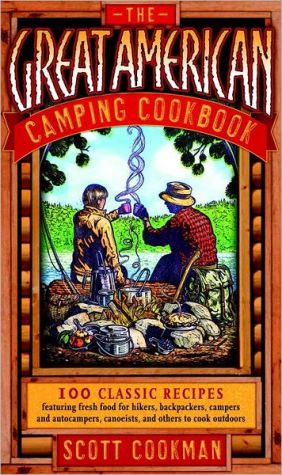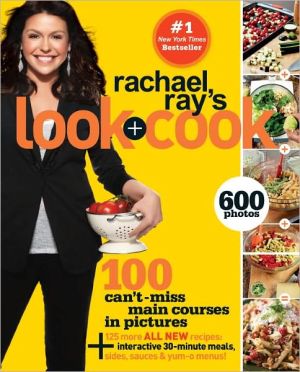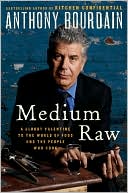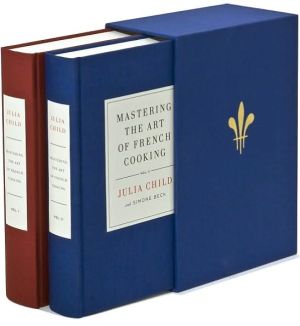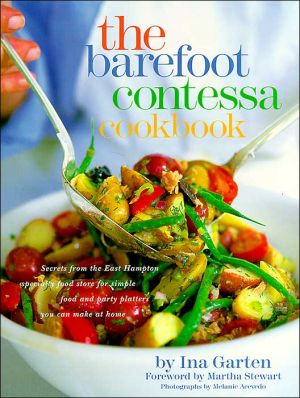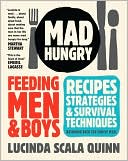The Great American Camping Cookbook
Bad cooking ruins more camping trips—America’s most popular outdoor vacation activity—than anything else except rain. The Great American Camping Cookbook offers the delectable remedy: a camp cook’s guide to the fresh, natural “comfort foods” of the good old days. Whether your camp is a civilized weekend cottage, a rustic hunting or fishing cabin, or a primitive canoeing or backpacking bivouac, this book can help anyone make meals as vibrant as the outdoors itself.\ Start the day with Wild...
Search in google:
Bad cooking ruins more camping trips—America’s most popular outdoor vacation activity—than anything else except rain. The Great American Camping Cookbook offers the delectable remedy: a camp cook’s guide to the fresh, natural “comfort foods” of the good old days. Whether your camp is a civilized weekend cottage, a rustic hunting or fishing cabin, or a primitive canoeing or backpacking bivouac, this book can help anyone make meals as vibrant as the outdoors itself.Start the day with Wild Rice Pancakes or fresh-baked Cornmeal Blueberry Biscuits. Sit down to a classic shore lunch of Beer-Battered Smallmouth, Campfire Potatoes and Hush Puppies, or simple sorrel-stuffed trout. On rainy days, simmer up a pot of real Corn Chowder or Camp-Style Bean Soup. For memorable main courses, serve up a substantial Modernized Brunswick Stew, Blackened Yellow Perch, or Sautéed Walleye with wild rice and mushrooms. For side dishes, try fresh Camp-Baked Beans, spit-roasted Acorn Squash, or Sand-Baked Potatoes. Then savor a legendary Hot Buttered Rum or Camp Old-Fashioned as a nightcap.In addition to recipes, The Great American Camping Cookbook offers a wealth of easy-to-follow advice on making perfect camp coffee and camp breads, calculating food portions, and composing provisions lists to assure variety and avoid forgotten essentials. The colorful history of American camp food and cooking—from the Jamestown settlement, Lewis and Clark, and Daniel Boone to Ernest Hemingway and John McPhee—adds fascinating lore to this essential guide to eating well in the great outdoors.
Chapter 1\ DINING WITH SAVAGES Original American Camp Cooking\ \ This is truly the land of Epicures.\ —ARTIST GEORGE CATLIN, 1832\ IN THE WINTER of 1609-1610, when England’s first colonists were starving to death at Jamestown, Virginia, Captain John Smith trekked to the nearest Native American village to beg, barter—or steal—food. “Extreme wind, rain, frost and snow caused us to keep Christmas amongst the Savages,” he gloomily recorded in his diary, expecting little. To his amazement, the “Savages” (Powhatans) proved lavishly generous and gregarious hosts. “We were never [made] more merry, nor fed on more good oysters, fish, flesh, wild fowl and good bread,” he wrote, “nor ever had better fires in England than in their dry, warm, smoky houses.”\ In fact, if Smith’s and other contemporary accounts are accurate, he feasted on choice Chesapeake or Chincoteague oysters up to one foot long. Blue crabs were so big that “one provided a feast for four men.” Fish included gourmet–caliber sea trout, weakfish, bluefish, and channel bass (red drum), some in excess of 40 pounds. Smith and his men were served venison loins, spit–roasted and seasoned with the black, sodium–rich residue of boiled–down hickory bark, which substituted admirably for salt. Leaner cuts were basted with clear bear fat or served with a dipping sauce made of “no end of oil from walnuts and acorns, which they know how to extract very well.” Fat ducks and geese were plentiful.\ The “good bread” Smith noted was made of a grain he'd never seen before—corn—ground into fine meal; mixed with boiling water, walnut oil, and dried berries into a stiff dough; wrapped in leaves; and baked in hot coals. For dessert, there were sunflower seeds and hickory nuts—altogether new to him—as well as “Very sweet” chestnuts. Afterward, the Powhatans invited him to smoke the cured leaves of a small, hardy native tobacco plant (Nicotianna rustica) that, soon exported to Europe, proved to be the salvation of Jamestown.\ Stuffed, Smith and his men returned to the colony. By spring of 1610, subsisting on food bartered or taken outright from the natives, they were among the last 60 colonists—of the original 215—left alive.\ This same scenario played itself out repeatedly among the first Europeans to penetrate the North American wilderness. Much to their astonishment, they found the natives’ food and cooking far better, more varied, and infinitely healthier than their own.\ Hernando de Soto and his Spanish conquistadors, who rampaged through the American Southeast in search of gold a half–century before Smith’s Englishmen arrived at Jamestown, learned this lesson quickly. De Soto’s nine ships landed 600 men at Tampa Bay in the spring of 1539. They carried with them over a year's worth of state-of-the-art, preserved European provisions: salted beef, pork, and herring; wheat flour in watertight casks; barrels of rice and dried peas; and kegs of onions, cabbage, and turnips pickled in brine. To furnish fresh meat on the hoof, they brought a herd of live cattle and a dozen pigs, the latter the first seen on the North American continent.\ It did them little good. The salted meat and pickled vegetables, leeched of vitamins and nutrients, resulted in scurvy. In Florida’s heat and humidity, the flour and peas went blue–black with mold and swarmed with weevils. Without forage, the cattle soon died. About all that remained were the swine, which de Soto jealously guarded as his last-resort, emergency provisions.\ In ruthless fashion, he fed his expedition off native foods plundered from the Indians. Foremost among these was corn: “Yellow for ordinary eating,” according to the expedition's diarist, “and white for flour, which made very fine bread.” Indeed, this native–grown grain, which contained more calories than the Spaniards' wheat flour, fuelled their march. So did other strange, but delectable, foods. From "the Savage's many fine fields, some a league [five miles] in extent," they looted mountains of beans, squash, and pumpkins—vegetables unknown in Europe, but rich in the nutrients, especially vitamins, their salt–cured provisions lacked. Taking native chiefs hostage along the way, they extorted huge quantities of other foodstuffs as well. “One chief,” the diarist recorded, “sent two thousand bearers loaded with rabbits, partridges, corn cakes and many dogs,” the latter esteemed a great delicacy. Another, held at swordpoint in modern–day South Carolina, “made a gift of 700 turkeys,” a bird unknown to the Spaniards but domesticated by the natives, whose flesh made fine eating and whose feathers made light, warm down blankets.\ Hostage–taking supplied de Soto with a galaxy of equally exotic foods. There were potatoes, which the conquistadors called “earth apples,” heartily disliked, and used primarily to feed their 113 war horses. There were sweet potatoes—not really potatoes, but roots related to the morning glory family—which they ate with great enthusiasm for their sugariness. There were bushels of altogether unfamiliar, yet delicious nuts, including pecans, peanuts, black walnuts, and hickory nuts. High in fat, they were greedily devoured right out of their shells or—pressed of their fine, clear oil by the Indians—used for shortening, frying, and baking. There were also baskets overflowing with fine, succulent grapes unknown in Europe—thick–skinned, seed-filled muscadines, Catawbas, and Concords. While the natives ate them fresh or dried, the Spaniards eagerly fermented them into a rough but swillable wine. In addition to grapes, there were wild plums, strawberries (“Finer and more delicate than those in Europe,” according to the chronicler), mulberries, tart persimmons, wild spinach, purslane, and wild onions.\ By robbing the Indians, de Soto survived handsomely for three years in the wilderness. He did not, however, survive the bloody trail he’d left behind. Near today’s Mobile, Alabama, his freebooters were attacked and nearly wiped out by Native American Mobilians. With the remnant of his force, he battled the native Chickasaws across modern–day Mississippi. In 1542, he died—not of starvation, scurvy, or any dietary deficiency disease, but of yellow fever–bearing mosquitoes on the banks of the Mississippi River. He never found the gold he was looking for. He could never have imagined that the foods laid on his table represented a mother lode far richer.\ Far to the north, Europeans still found fine eating. Even among the hunter–gatherer peoples of the interior, the variety and sophistication of New World cuisine more than equaled that of the Old.\ On his epic canoe crossing of North America in 1792, explorer Alexander Mackenzie set out with typical voyageur’s provisions: dried peas, premade ship’s biscuit (hardtack), and casks of salted pork. The ultralight, long–life rations of their day, they provided a regular, but relentlessly monotonous menu: hardtack and raw pork while underway, pea and pork porridge thickened with broken hardtack at night. Luckily, Mackenzie found himself lavishly feasted by scores of Native American nations on his journey west. Indeed, his journal constitutes something of a gastronomic cross-section of the continent at the time—a “foodie’s” memoir, if there ever was one.\ Around the Great Lakes, the Ottawa (reputed to be the finest canoemen and anglers on the lakes) treated him to “fat [lake] trout,” “exquisite” whitefish, and “handsomely smoked sturgeon.” Considering the lake trout were up to five feet long and the sturgeon as much as ten, the bounty was even more impressive. West of Lake Superior, the Ojibway regaled him with “wild rice sweetened with [maple] sugar.” This grain, as unique to America as corn, was not only gourmet fare, but spectacularly nutritious, with twice the protein, double the iron, and more than ten times the vitamins of brown rice. Stewed with native–made maple sugar, it made a near-perfect, balanced “power meal” that happily propelled Mackenzie and his paddlers west.\ Along the forested rivers and lakes of the interior, the Assiniboine treated him to roast bear liver “wrapped in caul fat”; beaver tails, skinned like fish and broiled over coals; muskrat “fried in pieces, like chicken”; and the native’s ultimate specialty: boiled moose nose. Mackenzie tasted the latter nervously, expecting a gelatinous mess. To the contrary, he found that the tip of the nose, sliced thin, consisted of delicate white meat, and the jowls a rich dark meat. He declared it “fine” and asked for more.\ When he reached the Pacific coast, his Nootka hosts presented him an appetizer of “a large dish of salmon roes, pounded fine and beat up with water, so to give it the appearance of cream.” This was followed by more salmon roe, mixed with gooseberries and sorrel leaves, which, Mackenzie recorded, added a distinct sweet–and–sour flavor to the salty eggs. For main courses, there were massive fillets of prime salmon, roasted, smoked, or boiled into rich chowder. For dessert, there were baskets overflowing with huckleberries and raspberries, “the finest I ever saw or tasted,” he wrote. On his return trip, Mackenzie found he'd lost all appetite for hardtack and rancid salt pork.\ Lewis and Clark, traversing the continent farther south in 1804–1806, met with an even greater gustatory variety. Win–tering among the Mandan on the Missouri River, they eagerly traded iron, lead, and the services of their blacksmith for native-grown produce. This bought them Arikara yellow beans, Hidasta shield beans, Mandan bride corn, Chippewa corn, Algonquian pumpkin, Indian (Sibley) squash, and Seneca sunflower seeds. The corn and beans, boiled together, made succotash, an ideally balanced protein and carbohydrate meal. Dried pumpkin was boiled, mashed, and whipped into succulent purees or soups. More frequently, however, during the long Dakota winter, the expedition used it as a natural sweetener for “flip”: a mixture of whiskey and water brought to a frothy boil with the insertion of a red-hot iron. The sunflower seeds were either pressed into a fine cooking oil or ground into rich flour.\ The explorers gorged on buffalo, the mainstay of the prairie, prepared in half a hundred native ways, the choicest parts being the hump and the tongue. “The upper hump of the bison, weighing four or five pounds,” wrote one explorer, “is called by the Indians the ‘little hump.’ This is usually of a harder, more compact nature than the rest and is usually put aside for keeping. The lower, larger part is streaked with fat and is very juicy and delicious. These are considered the delicacies.” The tongue, however, was generally thought the ultimate morsel. It was soaked in water for 24 hours, boiled slowly for six, along with wild onions and herbs, then fried in what was called “prairie butter,” or buffalo marrow. An even richer rich dish, a soup of buffalo blood and marrow, left the explorers “ashine with grease and gladness.”\ Crossing the Rockies, the expedition gratefully traded with the Nez Perce for camas—“a small, roundish root about the size of a small Irish potato,” wrote Clark, “which the natives roast in the embers until soft. It has a very agreeable taste and answers very well in place of bread.” Fermented, according to Clark, it also made “a verry [sic] good beer.”\ Wintering on the Pacific coast, the explorers developed a similar appetite for the foods of the native Clatsop. They traded their diminished stock of goods for immense quantities of fresh, dried, and smoked salmon, halibut, clams, whale meat, and smelt. Of all these, Clark, a man who’d experienced a continent's worth of the finest native fare, judged the tiny candlefish, or eulachon (a smelt), the most noteworthy of all. “I found them best when cooked in Indian stile [sic],” he wrote, "roasting a number of them together on a wooden spit, without any previous preparation whatever. They are so fat they require no additional sauce. I think them superior to any fish I ever tasted, even more delicate and lussious [sic] than the whitefish of the Great Lakes, heretofore my standard for excellence among the fishes.” Pressed of their oil, the candefish furnished a rich dipping sauce for lean, winter–starved elk meat. The surplus oil fuelled the expedition’s lamps, affording Lewis and Clark light to keep their journals.\ The artist George Catlin, who first painted the Native Americans of the high plains some 25 years after Lewis and Clark's expedition, found Indian food—and hospitality—equally memorable. In 1832, among the Mandan on the upper Missouri River, he was invited to a simple lunch. In a lodge 50 feet in diameter, he was seated on finely woven, multicolored rush mats laid with “handsome crockery bowls and buffalo horn spoons, polished bright as silver.” He wrote that "the simple feast which was spread before us consisted of stewed pemmican [dried, shredded buffalo meat, pounded fine, larded with fat and marrow], a fine brace of buffalo ribs, delightfully roasted, and a kind of paste or pudding, made of the flour of the pomme blanche, as the French [traders] call it, a delicious turnip of the prairie [Jerusalem artichokes], finely flavored with buffalo berries.” For dessert, he was presented with “great quantities of wild fruit—service berries, strawberries and wild plums.” He ate his fill and confessed to his diary afterward: “This is truly the land of Epicures.”\ The abundance, variety, and gustatory goodness of Native American cuisine impressed other whites as well. At Christ-mas in 1845 another wayward artist named Paul Kane, crossing the continent by canoe and dog sled to paint Indians, found himself marooned by deep snow at the Hudson Bay Company’s (HBC) remote outpost at Fort Edmonton in Alberta, Canada. The company–supplied fare at such posts—the HBC being notoriously cheap—was unrelievedly monotonous. Expecting a dismal meal of ossified salt beef and corn gruel, Kane wrote: “About two o’clock on Christmas Day, we sat down to dinner.”\ His mood improved following a “regale”—a full eight-ounce mug—of 100–proof brandy. He was surprised to see the table heaped with fresh native foods. “At the head of the table was a large dish of boiled buffalo hump," he noted, “[while] at the foot smoked a [whole] boiled buffalo calf.” The sight of the latter unnerved him. But his host assured him to “fret not, the calf is very small and is taken from the cow by Caesarian operation long before it attains full growth. This, boiled whole, is one of the most esteemed dishes among epicures of the interior.” Indeed he was told it was equivalent to a “suckling pig of the plains” and fine eating, which he quickly found it was.\ There was no formality about the feast. Everyone at the table tucked into it family–style. “My pleasing duty,” Kane wrote, “was to help a dish of mouffle, or dried moose nose [a native specialty]. The gentleman on my left distributed whitefish, delicately browned in buffalo marrow. The priest served the buffalo tongue, while the chief trader cut up beavers’ tails. The other gentleman at the table was occupied in dissecting a roast wild goose. The center of the table was graced with piles of potatoes, turnips [Jerusalem artichokes] and Indian [corn] bread.”\ Like Captain John Smith’s, some 250 years before, it was the finest Christmas dinner Kane ever remembered.
